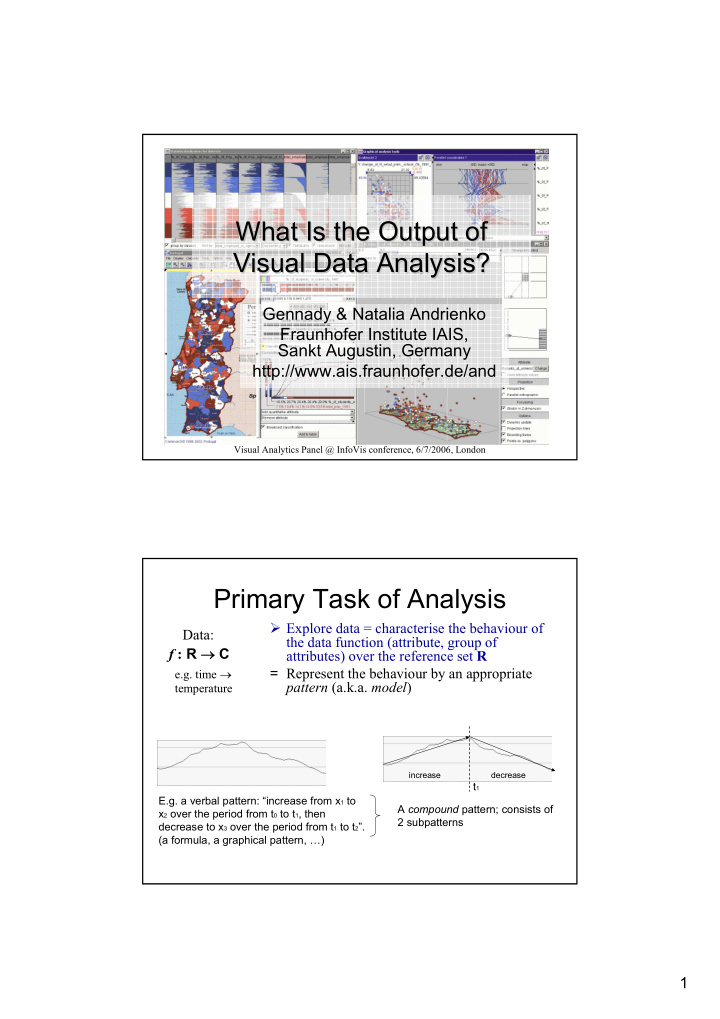



What Is the Output of What Is the Output of Visual Data Analysis? Visual Data Analysis? Gennady & Natalia Andrienko Fraunhofer Institute IAIS, Sankt Augustin, Germany http://www.ais.fraunhofer.de/and Visual Analytics Panel @ InfoVis conference, 6/7/2006, London Primary Task of Analysis � Explore data = characterise the behaviour of Data: the data function (attribute, group of f : R → C attributes) over the reference set R = Represent the behaviour by an appropriate e.g. time → pattern (a.k.a. model ) temperature increase decrease t 1 E.g. a verbal pattern: “increase from x 1 to A compound pattern; consists of x 2 over the period from t 0 to t 1 , then 2 subpatterns decrease to x 3 over the period from t 1 to t 2 ”. (a formula, a graphical pattern, …) 1
Requirements to Visual Tools • Primary task: characterise the behaviour of the data function over the reference set ⇒ The analyst needs a tool allowing him to see simultaneously the entire reference set and all the corresponding characteristics ⇒ The tool should represent the characteristics so that they perceptually merge into a single unit (to be seen as a behaviour rather than multiple separate characteristics) E.g. a good representation: all characteristics are represented by a single line, which is perceived as a unit � But… such a representation is seldom achievable Data Complexities � Multi-dimensionality � e.g. time × space → temperature � Multiple attributes � e.g. time × space → (temperature, wind, precipitation, …) � Large data volume � e.g. (t i , s i , temp i , wind i , prec i , …) ; i = 1, 2, …, 1 000 000, … � Complex, heterogeneous nature of the reference set � e.g. geographical space: land, water, mountains, cities, … � Outliers, discontinuities, … 2
Need for Analysis and Synthesis The main task: Characterise ? Overall Overall behaviour pattern But… The data are too complex! Need for Analysis and Synthesis The main task: Characterise ? Overall behaviour Analyse Partial behaviours 3
Need for Analysis and Synthesis The main task: Characterise ? Overall behaviour Analyse Partial Partial behaviours patterns Characterise Need for Analysis and Synthesis Overall Overall behaviour pattern Synthesise Analyse Partial Partial behaviours patterns Characterise Tool requirements: – Support analysis, i.e. division into partial behaviours – Support the characterisation of the partial behaviours – Support the synthesis of the overall pattern 4
Example: Behaviour over a Two- Dimensional Reference Set Referrers Attributes • Property crime rate • Violent crime rate • … Space (set of the states of the USA) Time (set of years from 1960 to 2000) This behaviour cannot be represented as a single unit Slicing a Behaviour Space as a whole Spatial behaviour (value distribution over the space) Specific time t Specific place Temporal behaviour (value variation over the time) Time as a whole 5
Aspectual Behaviours Time as a whole Space as a whole Spatio-temporal behaviour Aspect 2: Spatial variation of the temporal behaviour Aspect 1: Temporal variation of the spatial behaviour … t 1 t 2 t 3 Exploring Aspectual Behaviours 1)Temporal variation of the spatial behaviour … 2) Spatial variation of the temporal behaviour � The diagrams are perceived as separate entities → the map must be scanned and cannot be grasped as a single image � Absence of ordering complicates seeking for � Highly synoptic views, but… specific behaviour patterns � no spatial context! � Diagram overlapping is a serious problem 6
A Possible Approach: Group By Similarity E.g. by applying cluster analysis Attend to particulars e.g. extreme changes 1. Transform the time graph to show changes 2. Select extreme changes in a specific year (here 2003) 7
Synthesising an Overall Pattern No good tools yet… Knowledge Synthesis Challenges • Decomposition of a complex data analysis task results in multiple unconnected observations about various aspects of the overall behaviour and interesting particulars • These are mostly visual impressions and tacit ideas • How to capture these observations? • How to put these together and to get something tangible? • How could this “something” look like? 8
What Is the Output of Visual Data Analysis? � This is an important scientific question � This is not only a scientific question but a matter of survival of the InfoVis community: – People believe more in texts and numbers than in visualisations (R.Burkhard) – Possibly, because they do not see material results, e.g. models supporting their decisions – A consequence: lack of industrial and research funding (at least in Europe) 9
Recommend
More recommend